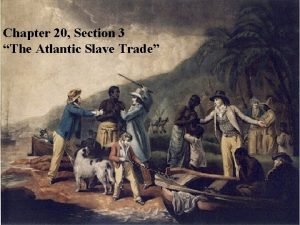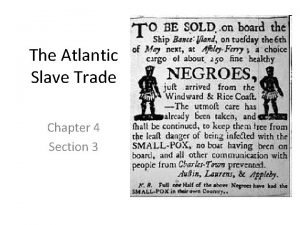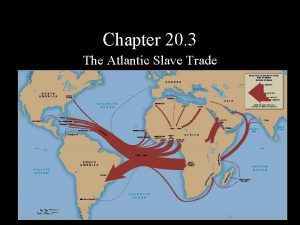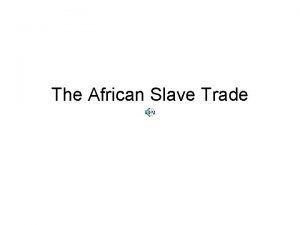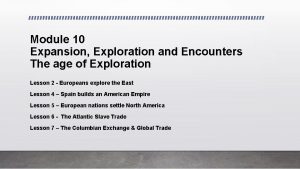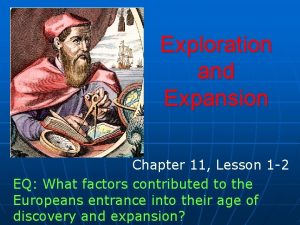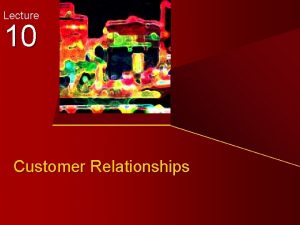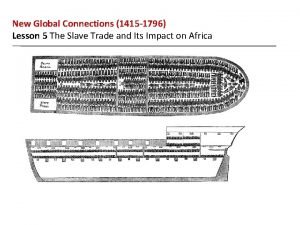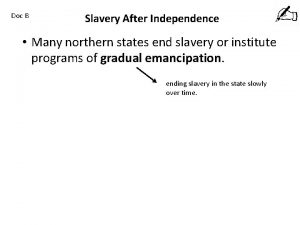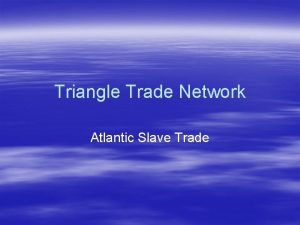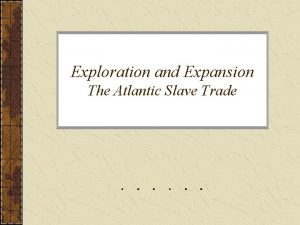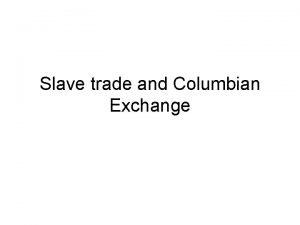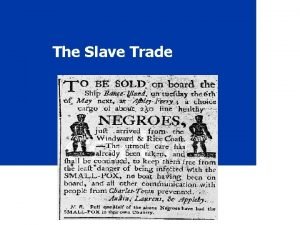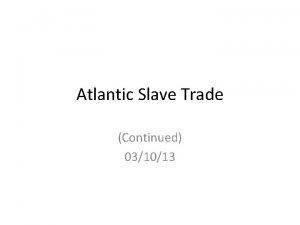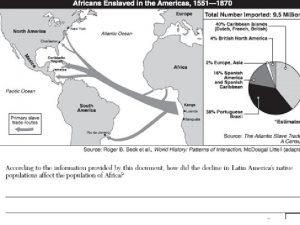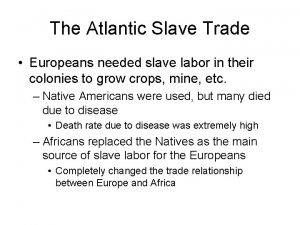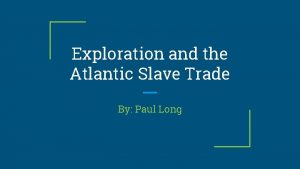Exploration and Expansion Section 4 The Atlantic Slave

















- Slides: 17

Exploration and Expansion Section 4 The Atlantic Slave Trade Preview • Main Idea / Reading Focus • Origins of the Slave Trade • Map: The Atlantic Slave Trade • Slavery in the Colonies • Effects of the Slave Trade • Visual Study Guide / Quick Facts • Video: The Impact of the Columbian Exchange on Europe and the Americas

Exploration and Expansion Section 4 The Atlantic Slave Trade Main Idea Between the 1500 s and the 1800 s millions of Africans were captured, shipped across the Atlantic Ocean, and sold as slaves in the Americas. Reading Focus • Where did the Atlantic slave trade originate? • How did slavery evolve in the American colonies? • What were the consequences of the slave trade?

Exploration and Expansion Section 4 Origins of the Slave Trade • Slavery has existed in many parts of the world • People forced into slavery came from different walks of life • Farmers, merchants, priests, soldiers, or musicians; fathers and mothers, sons and daughters. Beginnings • Shortage of labor in Americas led to beginning of Atlantic slave trade Native Americans • Planters first used Native Americans; European diseases killed millions • European planters needed workers on sugar, tobacco plantations • 1600 s, used indentured servants • Expensive to support workers African Slaves • Millions forcibly taken to Americas • Most from coast of West Africa • Some exchanged for firearms, goods • Others kidnapped on raids by traders

Exploration and Expansion Section 4 Trade Network Captured Africans became part of network called the triangular trade • First leg of triangle, ships carrying European goods to Africa to be exchanged for slaves • Second leg, Middle Passage, brought Africans to Americas to be sold • Third leg carried American products to Europe • Some slave traders from Americas sailed directly to Africa, not following triangular route

Exploration and Expansion Section 4

Section 4 Exploration and Expansion Middle Passage Ordeal • Middle Passage, terrifying ordeal • Captive Africans chained together, forced into dark, cramped quarters below ship’s decks • Could neither sit nor stand • Journey lasted three to six weeks, ten to twenty percent did not survive Horrific Conditions • Olaudah Equiano wrote about conditions on slave ship: • “The stench of the hold…was so intolerably loathsome, that it was dangerous to remain there for any time… • “The shrieks of the women, and the groans of the dying, rendered the whole scene of horror almost inconceivable. ”

Exploration and Expansion Section 4 Describe What was the Middle Passage of the slave trade like? Answer(s): a terrifying ordeal; people were cramped, chained together; as many as one in four people did not survive the voyage

Section 4 Exploration and Expansion Slavery in the Colonies • Slave traders carried captive Africans throughout the Americas • Spanish—Caribbean sugar plantations; Portuguese—Brazil; English —West Indies but also to colonies in North America. • England dominated the slave trade by end of 1600 s Jobs Living Conditions • Most slaves worked on plantations • Others worked in mines, in towns, in the countryside • Skilled craft workers—carpenters, metalworkers, coopers—continued crafts in Americas • Women given domestic duties • Slaves had to meet own basic needs at end of workday • Cooking, mending, tending the sick fitted in around work for slaveholder • Living conditions harsh • Physical, degrading punishment inflicted for minor offenses Many slaveholders lived in constant fear of rebellion by angry slaves who could no longer take harsh treatment they faced on plantations.

Exploration and Expansion Section 4 Property • Laws in Americas considered enslaved Africans to be property • Slaves had no rights, freedoms • Slaveholders controlled most conditions under which they lived • Often enslaved people endured brutal treatment, abuse Resistance • Slaves coped with inhumane conditions many different ways • Some resisted by trying to keep cultural traditions alive • Others turned to religion for strength, hope • Some fought back by slowing work, destroying equipment, revolting • Some able to flee, establish communities of runaways

Exploration and Expansion Section 4 Summarize Why did many slaves fight back against their owners? Answer(s): to cope with inhumane conditions

Exploration and Expansion Section 4 Effects of the Slave Trade • 400 years of Atlantic slave trade • Devastated West African societies Cost of Slave Trade • Estimates of 15 to 20 million Africans shipped to Americas against will • Millions more sent to Europe, Asia, Middle East • Human cost enormous – Countless died in transit – Millions deprived of freedom – Descendants doomed to lives of forced servitude Effect on Africa • Effects profound in Africa • Slave raiders captured strongest young—future leaders of societies • Divided Africans one from another—some rulers waged wars to gain captives • Forced labor of millions of Africans did not enrich Africa

Exploration and Expansion Section 4 Economies • Forced labor of Africans did enrich other parts of world • Labor of African slaves built economies of many American colonies • Their knowledge of agriculture contributed to growth of rice industry in southern English colonies Spread of Culture • As result of slave trade, people of African descent spread throughout Americas, Western Europe • Spread called African Diaspora • Eventually led to spread of African culture—music, art, religion, food —throughout the Western World

Exploration and Expansion Section 4 Explain What effects did the Atlantic slave trade have in Africa? Answer(s): took away future leaders; divided Africans from one another

Exploration and Expansion Section 4

Exploration and Expansion Section 4

Exploration and Expansion Section 4

Exploration and Expansion Section 4 Video The Impact of the Columbian Exchange on Europe and the Americas Click above to play the video.
 The age of exploration outcome the atlantic slave trade
The age of exploration outcome the atlantic slave trade The age of exploration outcome the atlantic slave trade
The age of exploration outcome the atlantic slave trade Chapter 20 section 3 the atlantic slave trade
Chapter 20 section 3 the atlantic slave trade Chapter 4 section 3 the atlantic slave trade
Chapter 4 section 3 the atlantic slave trade The atlantic slave trade chapter 20 section 3
The atlantic slave trade chapter 20 section 3 Atlantic slave trade
Atlantic slave trade What is triangle trade
What is triangle trade Module 10 expansion exploration and encounters
Module 10 expansion exploration and encounters Guided reading activity 13-1 exploration and expansion
Guided reading activity 13-1 exploration and expansion Committmebt
Committmebt Awareness exploration expansion commitment dissolution
Awareness exploration expansion commitment dissolution Awareness exploration expansion commitment dissolution
Awareness exploration expansion commitment dissolution Master morality
Master morality Lesson 5 the slave trade and its impact on africa
Lesson 5 the slave trade and its impact on africa Slavery states map
Slavery states map Hình ảnh bộ gõ cơ thể búng tay
Hình ảnh bộ gõ cơ thể búng tay Lp html
Lp html Bổ thể
Bổ thể


